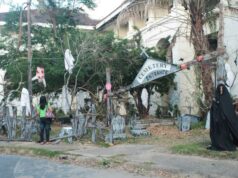Customers scout for sacks of colored stones along the highway in Bagting, Gabaldon, Nueva Ecija that they intend to buy.
PHOTO BY ANSELMO ROQUE
CABANATUAN CITY – The one thing residents of Barangay Bagting, in Gabaldon, Nueva Ecijahate is the rushing down from the mountains of floodwaters. It inundates their village. Typhoons Ondoy and Pepeng, like the rest of the other typhoons that rushed thru their village, were considered most appalling in its after effects, particularly flooding.
Ondoy lashed out its fury on September 26, 2009 and a week after, Pepeng lashed thru the areas affected by Ondoy, Barangay Bagting included. Their extended heavy rains resulted in floods which according to weather experts, had a return period of 50 years or statistically occurring once in a half century.
The river in Bagting swelled and the floodwaters destroyed the village residents’ vegetable crops. They particularly noted that the rushing water in the river seemed like “angrier” than what they experienced before.
The angry flood water, though, unraveled to the residents what turned out to a comparatively lucrative source of income. “It was my mother Imelda who noted the colored stones in the river bed which were washed down from the mountain,” Joan Rafael, 20, said. “She hired some of the boys to pick the stones for her, placed them in a sack, and offered them for sale by the roadside,” she added.
That started their business which 25 others in their village emulated, she added. Rafael, early in the morning she was contacted for an interview in her place about 47 kilometers east of here, was recording the loading of 1,500 sacks of colored stones bought by a Bulacan garden plants operator.
She said the buyer was paying her P50,000. Many other traders from the rest of Nueva Ecija and from nearby provinces have been buying the stones from the other sellers in their village. Every now and then, she added, small vehicles stop in their village to buy the bags of stones piled on the sides of the highway leading to the town proper here and to the coastal town of Dingalanin Aurora province.
The pebbles come inred, white, green, blue, popcorn (brown), cookies (brown), orange and in multi-color. They are placed in especially sewn bags similar to those used for bagging onions and garlic with some of them labeled as “crystal” (pure white), “seven colors” (assorted), “cracked” (striped), “multi-color” and others.
They sell the pebbles at P30 to P35 per bag. Also offered for sale are corrals and varying sizes of boulders which sells as much as P250 and as low as P5 apiece. Joan, who serves as her mother’s assistant in the business, said the colored stone selling activity in their village has also provided a source of income for young boys and adults alike.
“They are paid P10 per sack for the stones they have gathered which we pick up from the river side,” she said.
“If it is delivered to us, we pay P14 per sack,’ she added. Joan said his father, and some others in the village, have also started stone-carving but they are hampered by lack of the needed equipment. ReynatoArim – buyutan, chair of the small and medium scale industries council in Nueva Ecija, suggested to Joan to organize themselves into a formal group so that it can qualify to be a recipient of shared facilities being given by the Department of Trade and Industry.




